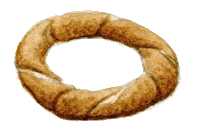Simit

Form: Ring-shaped
Country of origin: Turkey
What distinguishes it from other methods of bread making: Simit is called “crusty” in Izmir. That’s how they like it in Turkey, as well as in Greece, where it is called koulouria
Category of bread: (3) Belongs to the category of crusty bread, preferably eaten straight out of the oven
Particularity: Sold by street vendors
Ingredients: Wheat flour; baker’s yeast; eggs; milk; oil; butter; sugar; sesame seeds

Turkey
It is sometimes difficult to mark a boundary, since the world of bread baking tends to ignore such concepts. If you talk about Turkish simit, you also have to mention koulouria, the Greek equivalent. Then there’s djevrek found throughout the Balkans. But if you spread even farther beyond these borders, you find the pain couronne in France. This bread was invented by Protestant bakers who, during the French Wars of Religions, thought they could keep their Catholic customers from hallmarking their bread, so from then on they put a hole in the middle.
But going back to our simit-koulouria twins is like bringing back to life the thousands of bonds that a single story, sometimes painful, created between two countries. The reasons for such a coming together are plentiful, in fact they leap out at you. First, the simit and the koulouria are both in the shape of a crusty ring of risen wheat dough, covered with sesame seeds, of a size that differs from one baker to another.
Street vendors sell these sesame rings, even if they are also offered in bread bakeries. You pass them in the street, pushing their makeshift carts, or set up on a street corner near a newspaper vendor, calling out to the passersby in a hurry. Sometimes they even get acrobatic, and carry the large platters holding the bread on their heads. At the end of the day, their clothes are covered with the sesame seeds from the simit and koulouria.

